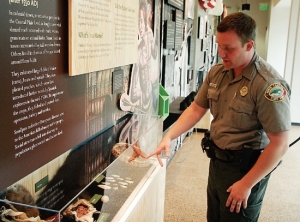Visitors center, museum set to open Friday at Cliffs
By Becky Barclay
Published in News on May 31, 2011 1:46 PM

News-Argus/AARON MOORE
Cliffs of the Neuse State Park superintendent Daniel Schewlakow talks about one of the exhibits in the cultural hall in the new museum/visitor center.
After two years of construction, a new museum and visitor center at the Cliffs of the Neuse State Park will open with a dedication ceremony Friday at 10:30 a.m.
The 7,000-square-foot facility will enable visitors to get a glimpse of life at the nature preserve, from the creatures that roam the park today to those who inhabited it millions of years ago, when the much of eastern North Carolina was covered by the sea.
The new building will house exhibits and classrooms where children will be able to create their own bird, fish from dry land and view fossil collections.
When visitors walk into the new museum and visitors center, to their right is an interactive exhibit hall that contains improved exhibits from the park's old museum along with new ones.
A fossil exhibit contains drawers that visitors may open to check out the kinds of fossils that were found in this area from three different time periods, like shark teeth, alligator teeth, sea urchins, corals, anemone and even a tooth from a sperm whale. Millions of years ago, the region was covered by water.
More fossils can be found in three big boulders outside the museum.
Another exhibit shows the cliffs in layers, showing the different soil levels and time periods.
An ancient seas display shows how the Earth's surface has moved over the years. A video talks about how land masses have changed, too.
Covering the entire back part of the exhibit hall is a children's area where young people can play and learn at the same time. They can sit in a red wood canoe and play a fishing game, trying to hook a fish with a pole that has a magnet on the end. Or they can watch carpenter ants in an ant farm or even make up their own bird by placing different kinds and colors of wings and heads on a bird body.
"Who Lives Here?" allows children to open cubbyholes and see what kinds of animals live in the park.
One activity that Schewlakow is sure will be a hit with children deals with the kinds of birds and bees that live in the park. They can turn a wheel that makes the birds go round and round. In the middle is a replica of a bald eagle's nest. There's also one of a hornet's nest.
One of Schewlakow's favorite exhibits uses the sense of touch. "Who's In There?" is a series of boxes that visitors put their hand into, without being able to see, and they try to guess what kind of creature it is. It's not real animal parts, though, just different items that feel like a particular animal would feel.
There are even examples of various scat (excrement) left by different animals in the park. "Who's Scat is That?" will help visitors identify various droppings left by animals on the park's trails.
Schewlakow said that many people don't know that there's a seismic station in the park, monitored by the United States Geologic Society. One of the displays in the exhibit hall ties in with that seismic station. Here, visitors can look at a touch screen that contains a map and see where there's seismic activity, locally and around the world.
"It shows active earthquakes all over the world and the size of the earthquake as well," Schewlakow said. "It's really fun. I've spent 20 or 30 minutes just playing on it myself."
There are also wall displays on the history of the cliffs, the springs in the park, water quality of Neuse River, river basins, pollution, river buffers and more.
"We tried to make the exhibit hall as interactive and educational as possible," Schewlakow said. "Exhibits actually stimulate all the senses, except taste."
Outside the exhibit hall is a display on how the new building was constructed to have the least amount of impact on the environment as possible, Schewlakow said.
The building is equipped with a geothermal system. Coils run from the new museum underground to the lake. The lake water warms and cools the coils to heat and cool the building. There are also solar panels on the roof. Windows instead of walls on much of the museum saves on electricity.
Across from the exhibit hall is the cultural hall, where an artist's rendition of the cliffs stands about eight feet tall and hangs on one wall. Schewlakow said it looks like a biologist's old notebook with field notes on plants and animals.
There is also information on native Americans, complete with artifacts such as an ore pouch, arrowheads, pine needle basket and more.
Another part of the display centers around naval stores, talking about tar and pitch, resin and turpentine and pines. Visitors can actually press a cylinder and smell the resin.
They can also look into old-time viewfinders and see 3-D photographs.
Other displays contain information on the Civil War, the CSS Neuse, the Seven Springs Hotel and old photos of the cliffs through today.
Classrooms will allow park rangers to give various programs to school students and other groups.
The museum and visitors center will be open from 8 a.m. to 5 p.m., seven days a week, depending on the availability of park staff.
